
With the rapid increase in the number of electric car models, the inevitable price drop is coming closer. With normal (million-dollar) production numbers, the investments in research, development, and production facilities will quickly be recouped, and the automotive industry can return to its comfortable margins. It’s not that far yet, but sales look good and impressive in this regard. Tesla’s Chinese factory posted record sales in the first quarter of this year, and the other Chinese brands also have very good prospects. Also, the VW ID.3 and ID.4 are doing well in Europe, among all the other brands, you see them around more and more. The new electric Dacia is the first electric car with a good range and a selling price under €20,000.
Norway is a guiding country in this respect. In the first quarter of this year, sales of gasoline and diesel cars there shrank to a historically low 10%. Norway wants to get rid of all new sales of gasoline and diesel cars as early as 2025, and it looks like that might happen as early as next year or the year after. Two or three years earlier than expected. Taxes, of course, are still very much the determining factor there. The cheapest, but heavily taxed, gasoline-powered VW Golf costs about €35,000 there, while the new electric VW ID.3 costs €28,000 in Norway. Those amounts are just the opposite here, despite the discount on the purchase tax, the BPM.

In many other countries, the tax breaks are not as generous. But because the total purchase, consumption, and maintenance costs of an electric car are already lower for the frequent driver, partly due to lower (road) taxes, sales in all other countries are now accelerating. All this leads to manufacturers increasing their production numbers and thus rapidly reducing their costs. And that, in turn, leads to higher sales. The stock prices of Tesla, VW, and the Chinese car brands have already priced that in.
To what extent can the situation in our country be predicted? Our government is aiming for sales of 100% fully electric cars by 2030, and only 15% by 2025. Last year, the percentage of all-electric was already 20%.
“Yes, this is the new era of automobility”
Maarten Steinbuch
And just imagine, it’s 2025: prices have dropped to the point where the purchase is about comparable, thanks in part to the discount on BPM. The cars have a tow bar if you want, and the range is easily 300 kilometers in summer and winter. There are plenty of charging points, at home, at work, at the charging plazas at major shopping centers. If you go out to eat, the restaurant offers you free charging options. On the highways, you’ll see several large fast chargers at all the gas stations. Last month, we are still in 2025, your neighbor bought an electric car. Further down the street, there are several families with electric cars, too. And you’ve already heard that they perfectly managed to go on vacation.
Now you are ready to buy a new car. Is it wise to think about buying a petrol or diesel car? After all, will you still be able to sell it after four or five years? So you also buy that electric car. You’ve actually been putting it off for too long. And when you drive it for the first time, you finally understand: yes, this is the new era of automobility. No more shifting gears, a quick response from your power pedal, no vibrations or noise, no worries about range, no stench, even when refueling. There is no going back. The future is electric. And Norway is leading by example. Already now, in 2021.
Maarten Steinbuch and Carlo van de Weijer are alternately writing this weekly column, originally published (in Dutch) in FD. Did you like it? There’s more to enjoy: a book with a selection of these columns has just been published by 24U and distributed by Lecturis.
